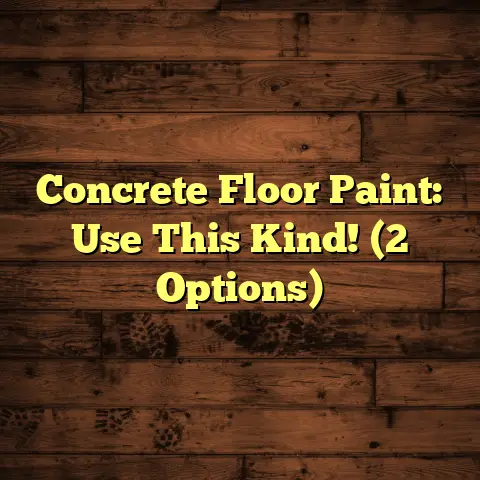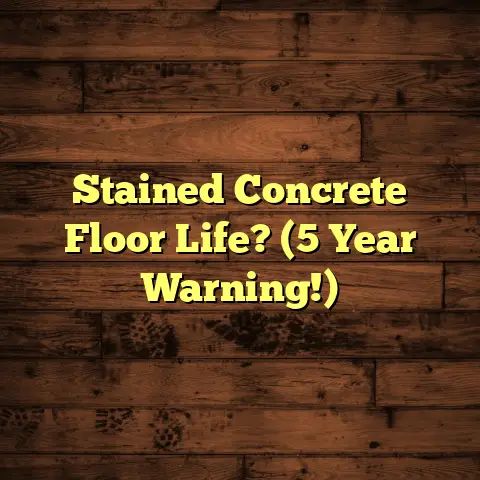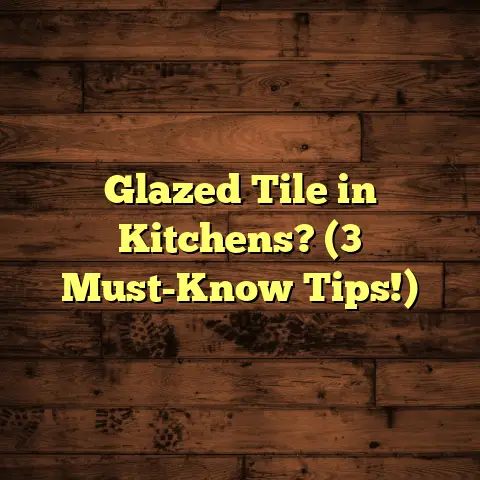Change a Laminate Floor Board? (5-Step Pro Fix!)
Laminate flooring: it’s the unsung hero of the home.
Why?
Because it’s tough, looks great, and doesn’t demand you sell a kidney to afford it.
Plus, unlike some diva flooring types, laminate is pretty chill when it comes to repairs.
No need to call in a small army of professionals for every little scratch or ding.
That’s where I come in.
I’m going to walk you through replacing a damaged laminate floorboard.
Think of it as a DIY project that even your grandma could handle (with a little help, maybe!).
Let’s dive in!
Section 1: Understanding Laminate Flooring
Overview of Laminate Flooring
So, what is laminate flooring, anyway?
It’s not real wood, that’s for sure.
Instead, it’s a multi-layered synthetic flooring product.
Imagine a delicious layer cake, but instead of frosting, you have layers of:
-
Wear Layer: The top layer, a clear, protective coating that resists scratches, stains, and fading.
Decorative Layer: A high-resolution photographic image of wood, stone, or other materials.
This is what gives laminate its realistic look.-
Core Board: A dense fiberboard core (usually High-Density Fiberboard or HDF) that provides stability and impact resistance.
-
Backing Layer: A bottom layer that provides moisture resistance and helps prevent warping.
Think of it as a carefully constructed sandwich, designed to look good and last long.
Benefits of Laminate Flooring
Why is laminate so popular?
Well, let me tell you, it’s got a whole bunch of things going for it:
Affordability: Let’s face it, hardwood can break the bank.
Laminate gives you the look without the hefty price tag.
I’ve seen homeowners save upwards of 50% choosing laminate over solid wood.Design Versatility: You want the look of oak?
Cherry?
Marble?
Laminate can mimic just about anything.
The possibilities are endless.Scratch Resistance: Got kids?
Pets?
Laminate can handle the wear and tear of daily life much better than many other flooring options.
According to the North American Laminate Flooring Association (NALFA), laminate floors must pass rigorous testing to ensure they meet certain standards for durability and resistance.Easy Installation: Many laminate floors feature a click-lock system, making installation a breeze.
I’ve personally installed a whole living room in an afternoon!-
Easy to Clean: A quick sweep and mop are usually all you need to keep laminate looking its best.
Common Issues with Laminate Flooring
Okay, so laminate isn’t perfect.
Like any flooring, it can have its issues.
Here are some common problems that might lead you to needing to replace a board:
-
Scratches: While scratch-resistant, laminate isn’t scratch-proof. Deep scratches can mar the surface.
Warping: Excessive moisture can cause laminate to warp or buckle.
This is especially true in areas with high humidity or where spills aren’t cleaned up promptly.Water Damage: While the backing layer provides some moisture resistance, laminate isn’t waterproof.
Standing water can seep into the seams and cause swelling and damage.-
Impact Damage: Dropping a heavy object can dent or crack a laminate board.
When these things happen, replacing the damaged board is often the best solution.
Section 2: Identifying a Damaged Laminate Floor Board
Signs of Damage
Alright, let’s get down to business.
How do you know when a laminate board needs to be replaced?
Here are some telltale signs:
Visible Cracks: Obvious, right?
A crack that runs across the board is a clear indication of damage.-
Warping: If the board is raised or uneven compared to the surrounding boards, it’s likely warped.
-
Stains: Stubborn stains that you can’t remove with regular cleaning might warrant replacement.
-
Swelling: If the board is noticeably thicker than the others, it’s probably swollen from water damage.
-
Chipped Edges: Chipped edges can be unsightly and can also create a tripping hazard.
Assessing the Extent of Damage
Okay, you’ve spotted a damaged board.
Now what?
Before you start tearing things up, take a closer look.
Is it just one board that’s affected, or is the damage more widespread?
Here’s what to consider:
-
Isolated Damage: If the damage is confined to a single board and the surrounding boards are in good condition, you can probably just replace that one board.
Widespread Damage: If multiple boards are damaged, or if the damage seems to be spreading, you might have a bigger problem, like a moisture issue.
In this case, you might need to replace a larger area of flooring.Check the Underlayment: While you’re assessing the damage, take a peek at the underlayment underneath the damaged board.
If it’s wet or damaged, you’ll need to replace that as well.
Pro Tip: If you’re unsure about the extent of the damage, it’s always a good idea to consult with a flooring professional.
Section 3: Tools and Materials Needed for Replacement
Alright, time to gather your supplies!
Here’s what you’ll need to tackle this project like a pro:
Essential Tools
Pry Bar: For gently lifting the damaged board.
A small, flat pry bar works best.-
Utility Knife: For scoring and cutting the damaged board, if necessary.
-
Measuring Tape: For accurately measuring the replacement board.
Hammer: For gently tapping the new board into place.
Use a rubber mallet to avoid damaging the surface.-
Tapping Block: A small block of wood that you place against the edge of the new board to protect it while you’re tapping it in.
-
Pull Bar: A metal bar with a hooked end that helps you pull the new board into place when you’re working near a wall.
-
Chisel: For cleaning up any adhesive residue or debris.
-
Safety Glasses: Protect your eyes from flying debris.
Materials
Replacement Laminate Boards: This is the most important part!
Make sure you get the exact same type and color of laminate as your existing floor.
If you don’t have any spare boards, you might need to order them from the manufacturer or a flooring supplier.
I always recommend buying an extra box or two when you initially install the floor, just in case you need them later.-
Underlayment (if needed): If the underlayment under the damaged board is also damaged, you’ll need to replace it.
Wood Glue (optional): Some people like to use a small amount of wood glue on the tongue and groove of the new board to help secure it.
This is optional, but it can provide extra stability.
Safety Gear
-
Gloves: Protect your hands from splinters and sharp edges.
-
Knee Pads: Trust me, your knees will thank you.
-
Dust Mask: Protect your lungs from dust and debris.
Pro Tip: Before you start, make sure you
have all your tools and materials organized and
within easy reach.
This will save you time and
frustration.
Section 4: Step-by-Step Guide to Replacing a Laminate Floor Board
Okay, let’s get to the fun part!
Here’s how to replace that damaged laminate board, step by step:
1. Preparation
-
Clear the Area: Remove all furniture, rugs, and other obstacles from the area around the damaged board.
Ventilation: If you’re using any adhesives or sealants, make sure the area is well-ventilated.
Open windows or use a fan.Inspect the Replacement Board: Before you start, carefully inspect the replacement board for any defects.
Make sure it’s the right size and color, and that the tongue and groove are in good condition.
2. Removing the Damaged Board
This is often the trickiest part, but don’t worry, you got this!
Score the Board: Use your utility knife to score the damaged board along the seams where it meets the surrounding boards.
This will help prevent chipping and splintering.Pry Up the Board: Insert the pry bar under the edge of the damaged board, near a corner.
Gently pry upwards, being careful not to damage the surrounding boards.-
Work Your Way Around: Continue prying up the board, working your way around the edges until it’s completely loose.
-
Cut if Necessary: If the board is difficult to remove, you might need to cut it into smaller pieces using your utility knife or a small saw.
Remove Underlayment and Debris: Once the damaged board is removed, clean up any underlayment or debris from the area.
Use a chisel to scrape away any adhesive residue.
3. Measuring and Cutting the Replacement Board
Accuracy is key here!
Measure the Space: Carefully measure the space where the new board will go.
Make sure to measure the length, width, and thickness.-
Transfer Measurements: Transfer the measurements to the replacement board.
Cut the Board: Use a saw to cut the replacement board to the correct size.
Be sure to cut along the back of the board to avoid chipping the decorative layer.Test Fit: Before you install the board, do a test fit to make sure it fits properly.
If it’s too tight, you might need to trim it down a bit.
4. Installing the New Board
Almost there!
Align the Board: Carefully align the new board with the surrounding boards.
Make sure the tongue and groove are properly aligned.Lock it In: Use a tapping block and hammer to gently tap the new board into place.
You should hear a click when the tongue and groove lock together.-
Use a Pull Bar (if needed): If you’re working near a wall, you might need to use a pull bar to pull the new board into place.
-
Adjust Underlayment: If necessary, adjust the underlayment underneath the new board to ensure a secure fit.
5. Finishing Touches
The final step!
-
Clean the Area: Use a damp cloth to wipe up any dust or debris from the area.
-
Re-install Baseboards or Trim: If you removed any baseboards or trim during the process, re-install them now.
Admire Your Work: Step back and admire your handiwork!
You just replaced a laminate floor board like a pro.
Section 5: Maintenance Tips Post-Installation
You’ve done the hard work. Now, let’s keep that floor looking fantastic!
Caring for New Laminate Boards
Regular Cleaning: Sweep or vacuum regularly to remove dirt and debris.
Use a damp mop with a mild detergent to clean the floor.
Avoid using excessive water, as this can damage the laminate.
I personally prefer using a microfiber mop – they’re super absorbent and gentle on the floor.Protective Measures: Place mats or rugs in high-traffic areas to protect the floor from wear and tear.
Use furniture pads under the legs of chairs and tables to prevent scratches.Avoid Harsh Chemicals: Don’t use harsh chemicals, abrasive cleaners, or scouring pads on laminate flooring.
These can damage the surface.
Regular Inspection
Check for Damage: Regularly inspect your laminate flooring for any signs of damage, such as scratches, warping, or stains.
The sooner you catch a problem, the easier it will be to fix.Address Moisture Issues: If you notice any signs of moisture damage, such as swelling or discoloration, address the issue immediately.
Identify the source of the moisture and take steps to prevent it from happening again.
This might involve repairing a leaky pipe or improving ventilation in the room.
Conclusion
So there you have it!
Replacing a laminate floor board isn’t rocket science.
With the right tools, a little patience, and this guide, you can easily tackle this DIY project and save yourself a lot of money.
Plus, you’ll get the satisfaction of knowing that you fixed it yourself!
Remember, laminate flooring is a great choice for homeowners who want a durable, attractive, and easy-to-maintain flooring option.
By following these tips and tricks, you can keep your laminate floor looking beautiful for years to come.
Now go forth and conquer those damaged floorboards!





